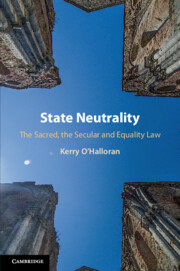Book contents
- State Neutrality
- State Neutrality
- Copyright page
- Dedication
- Contents
- Acknowledgements
- Introduction
- Part I Background
- 1 State Neutrality: Background History, Concepts, Definitions and Principle
- 2 Civil Society: Pluralism, Multiculturalism and the Church–State Interface
- 3 International Treaties, Conventions, Protocols, Courts and the European Court of Human Rights Rulings
- Part II The Benchmark of State Neutrality
- Part III Towards a More Stable Civil Society
- Conclusion
- Index
1 - State Neutrality: Background History, Concepts, Definitions and Principle
from Part I - Background
Published online by Cambridge University Press: 15 January 2021
- State Neutrality
- State Neutrality
- Copyright page
- Dedication
- Contents
- Acknowledgements
- Introduction
- Part I Background
- 1 State Neutrality: Background History, Concepts, Definitions and Principle
- 2 Civil Society: Pluralism, Multiculturalism and the Church–State Interface
- 3 International Treaties, Conventions, Protocols, Courts and the European Court of Human Rights Rulings
- Part II The Benchmark of State Neutrality
- Part III Towards a More Stable Civil Society
- Conclusion
- Index
Summary
Overviews the church–state relationship across time and nations, drawing attention to countries and circumstances in which the neutrality principle does not apply. Explores the origins of the doctrine, traces its developmental history in relation to religion in various countries, explains key concepts and identifies some different academic interpretations. Discusses the public/private dimensions to religious belief and their balancing within the Western liberal democratic model of government. It gives an overview of the law relating to religious freedom.
- Type
- Chapter
- Information
- State NeutralityThe Sacred, the Secular and Equality Law, pp. 9 - 44Publisher: Cambridge University PressPrint publication year: 2021

